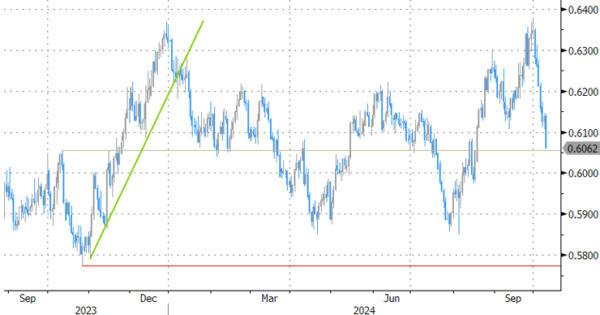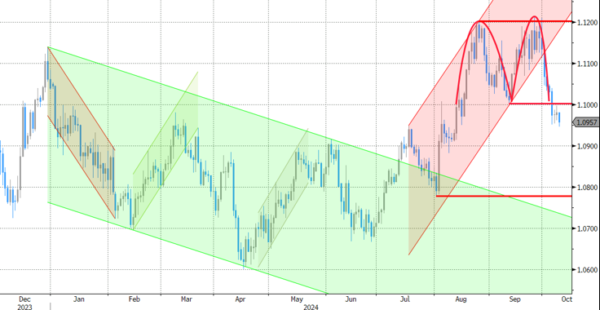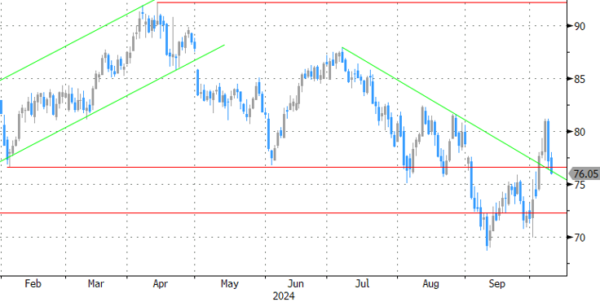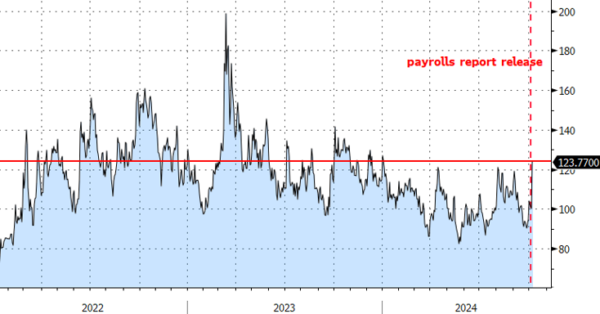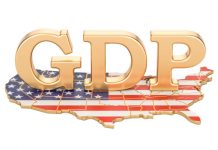Markets
The announcement that Chinese Finance Minister Lan Fo’an will hold a briefing on fiscal policy on Saturday to shore up growth only briefly supported Chinese stocks. They succumbed into the close, ending 6% to 8% lower. Unlike yesterday, this Chinese setback didn’t hurt general risk sentiment. Key European stock markets are currently mixed. US stock markets opened near flat. Core bond markets also showed little momentum. US yields added 1.1 bp (2-yr) to 3.3 bps (30-yr) with the long end of the curve preparing for the continuation of the US Treasury’s mid-month refinancing operation ($39bn 10-yr Notes tonight and $22bn 30-yr Bond tomorrow). Fed comments all point in the same direction: delight about the market repricing towards a 25 bps rate cut in November. “What’s the rush? 2.0”. FOMC Minutes will tonight deliver more insights on the internal Fed debate which culminated in a near-consensus decision to lower the policy rate by 50 bps in September. Tomorrow’s September US CPI inflation has the potential to spark some new volatility though we think investors won’t be easily tempted into moving back in 50 bps rate cut bets. German Bunds outperform US Treasuries with daily changes on the German yield curve ranging between +0.6 bps (2-yr) and -0.6 bps (30-yr). The German government downgraded this year’s growth forecast from +0.3% to -0.2%, hoping that a revival in domestic consumption, international demand for industrial goods and a resurgence in investment activity would result in a +1.1% growth recovery next year and 1.6% in 2026. If the projections come true, it would be the only G7 member to post shrinking output in a copy paste of 2023. The last time the German economy declined for two years in a row was in 2002-2003, which in turn was the first occurrence since the reunification. Inflation over the 2024-2026 period should ease from 5.9% in 2023 to 2.2%-2%-1.9%. ECB members profited from the final day before the start of the blackout period in the run-up to next Thursday’s policy meeting to give some final comments. ECB Stournaras in an FT article this morning argued in favour of cutting the policy rath both in October and December. Most of his colleagues just stick with backing (Kazaks, Patsalides, Villeroy) or in any case not ruling out (Nagel, Schnabel, Wunch) such action next week. ECB Kazimir is the only one to offer some counterweight: “It’s considered a done deal in the media that rates should be lowered. But I have to say I’m not completely convinced that we should make decisions based on one good (inflation) number.” In FX space, the US dollar finally manages to build on Friday’s technical break through resistance levels. The relative yield dynamic and neutral risk management outweigh a new decline in oil prices (Brent crude $76/b from $78/b). The trade-weighted greenback changes hands at 102.75, the best level since mid-August, from a start at 102.48. EUR/USD mirrors the move, changing hands at 1.0950. That’s the lowest level since that same reference period.
News & Views
The Hungarian economy minister Nagy declared victory over inflation today. The country posted the fastest price growth in the EU with a peak in early 2023 of a whopping 25.7%. Inflation since then eased back towards the 3% +/- 1 ppt tolerance range of the central bank. Nagy appeared to focus on headline inflation only, which came in at 3.4% in August. Analysts expect tomorrow’s September update to have further dropped to 3.1%. However, the Hungarian central bank (MNB) has been telling for several months that inflation in Q4 will reaccelerate to 4%+. The same goes for core measures, which currently still hover well north of 4%, and are expected to fluctuate around 5% for the rest of the year. For Nagy, though, it’s time to focus on reviving economic growth amid a weaker-than-expected recovery. PM Orban some weeks ago already hinted at increased fiscal spending in 2025 in the run-up of the 2026 election year, potentially complicating matters for the central bank which is already walking a tightrope. The MNB has cut rates to 6.5% over the past year. While its vice-governor Virag back in September said there could be cuts at all three of the remaining meetings in 2024, he backtracked yesterday. Virag said he sees less chance of an October cut after recent forint weakness pushed EUR/HUF north of 400 for the first time since March of last year. EUR/HUF in the meantime pared some of the gains to 398.
Graphs
NZD/USD: combination of RBNZ-triggered NZD weakness and USD strength
EUR/USD: dollar finally building on post-payrolls technical break
Brent crude prices correct further towards to previous neckline of double bottom formation ($75/b)
Bond volatility index: investors reckon that it’s data dependece to the fullest these days for central banks




